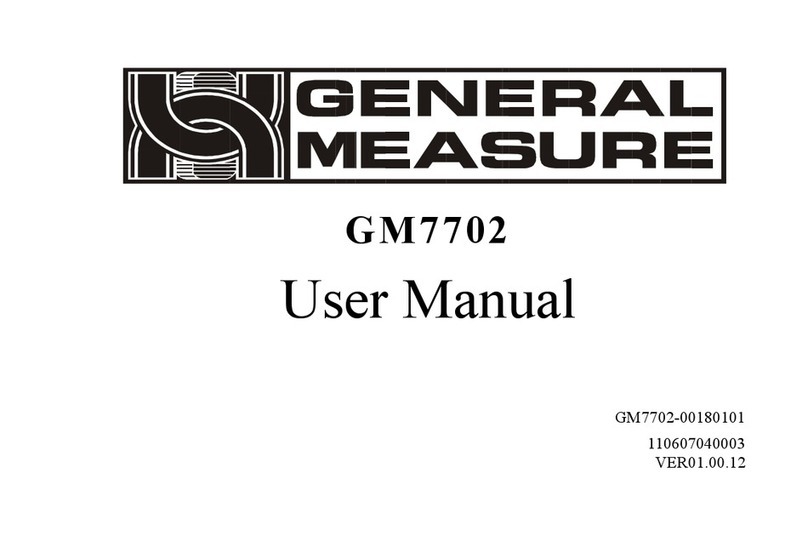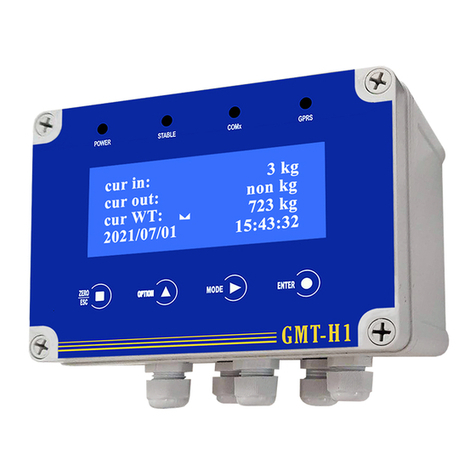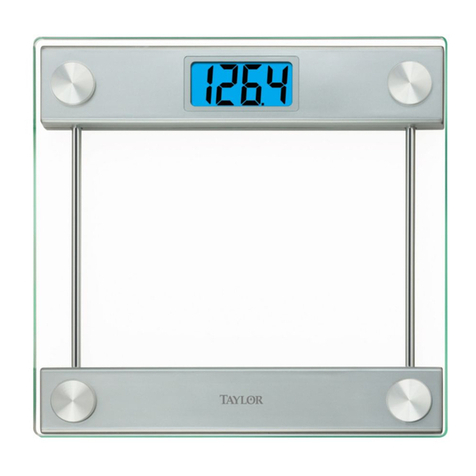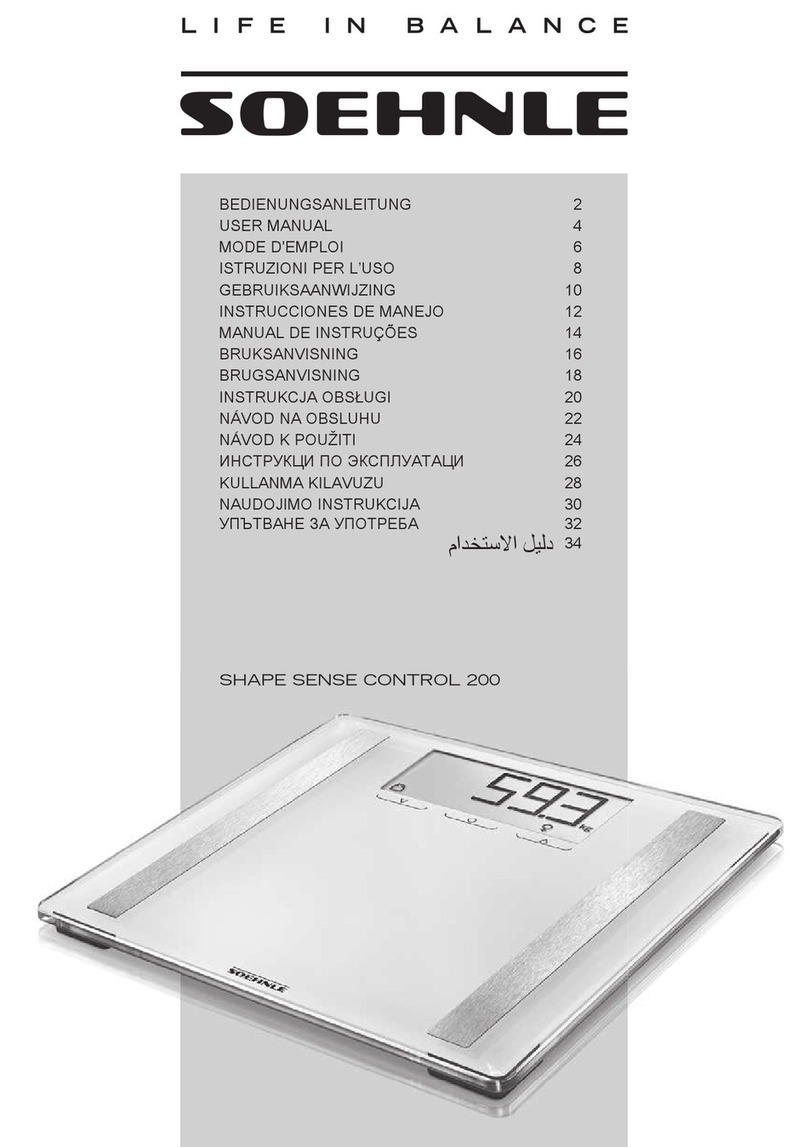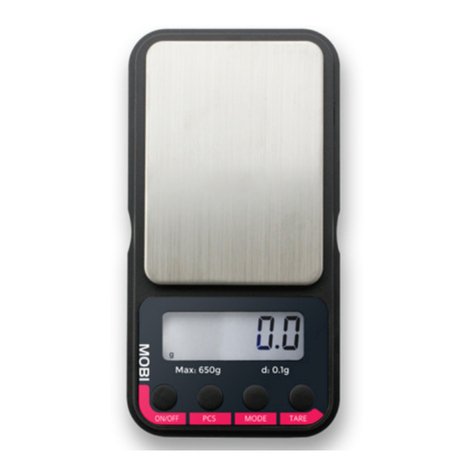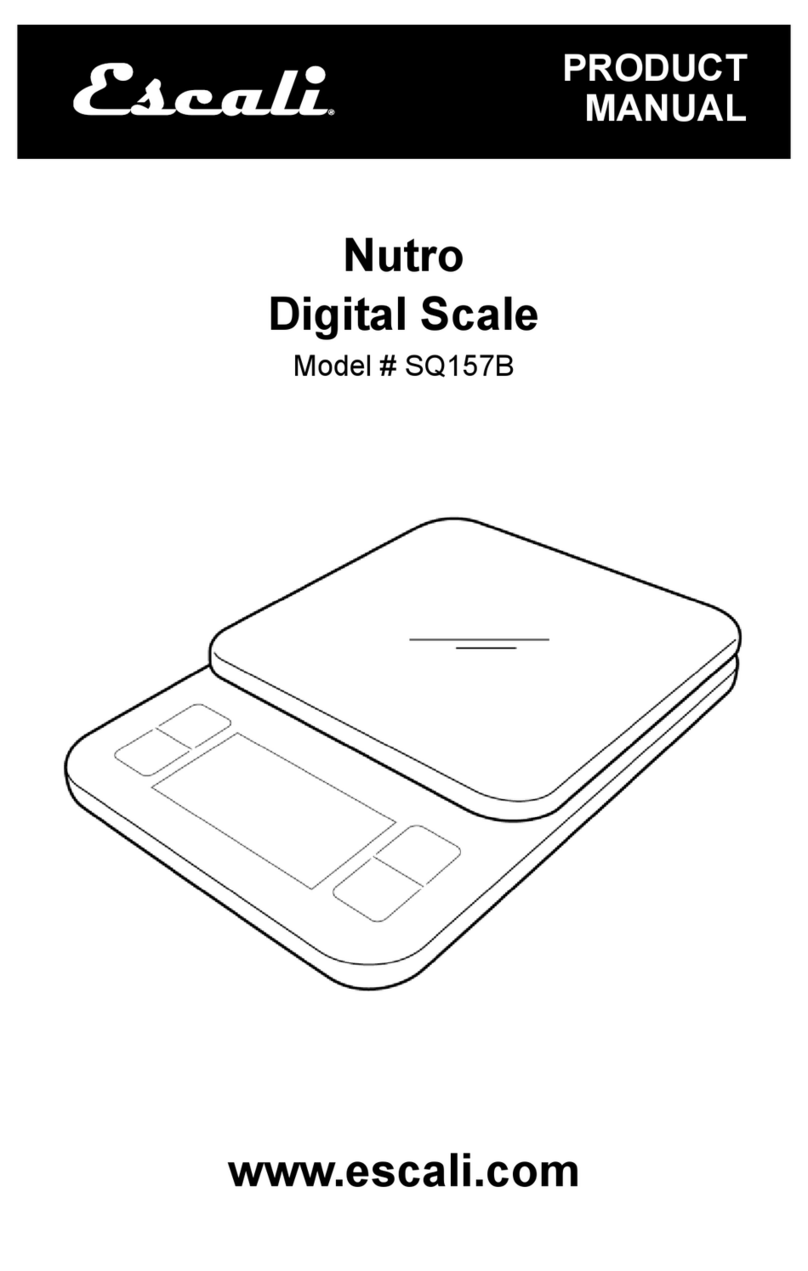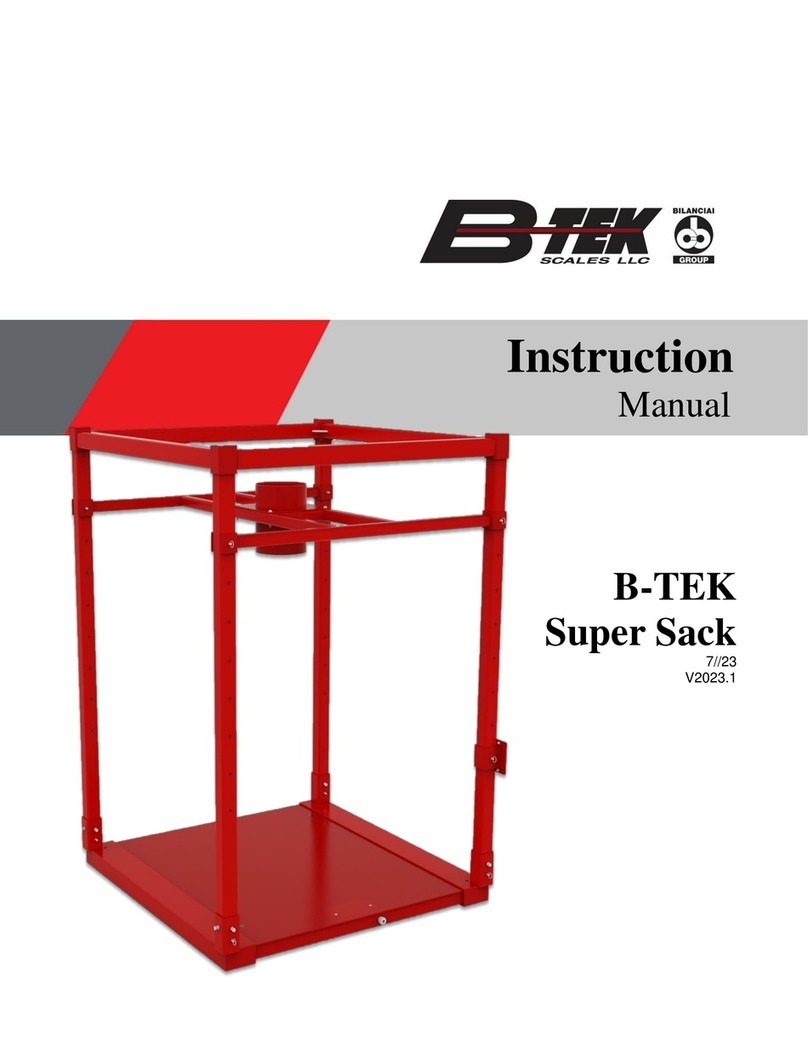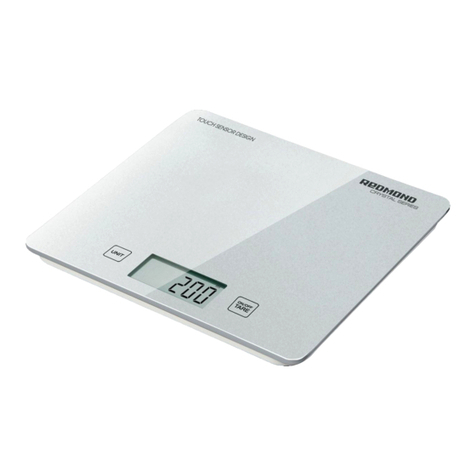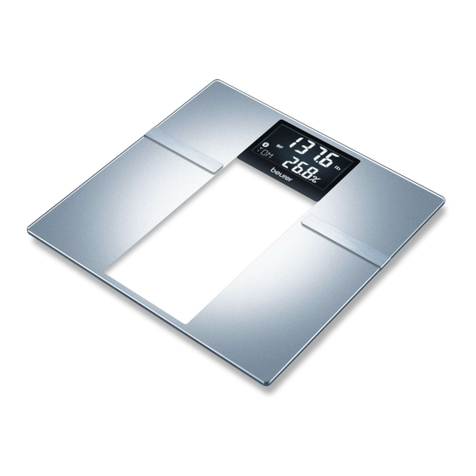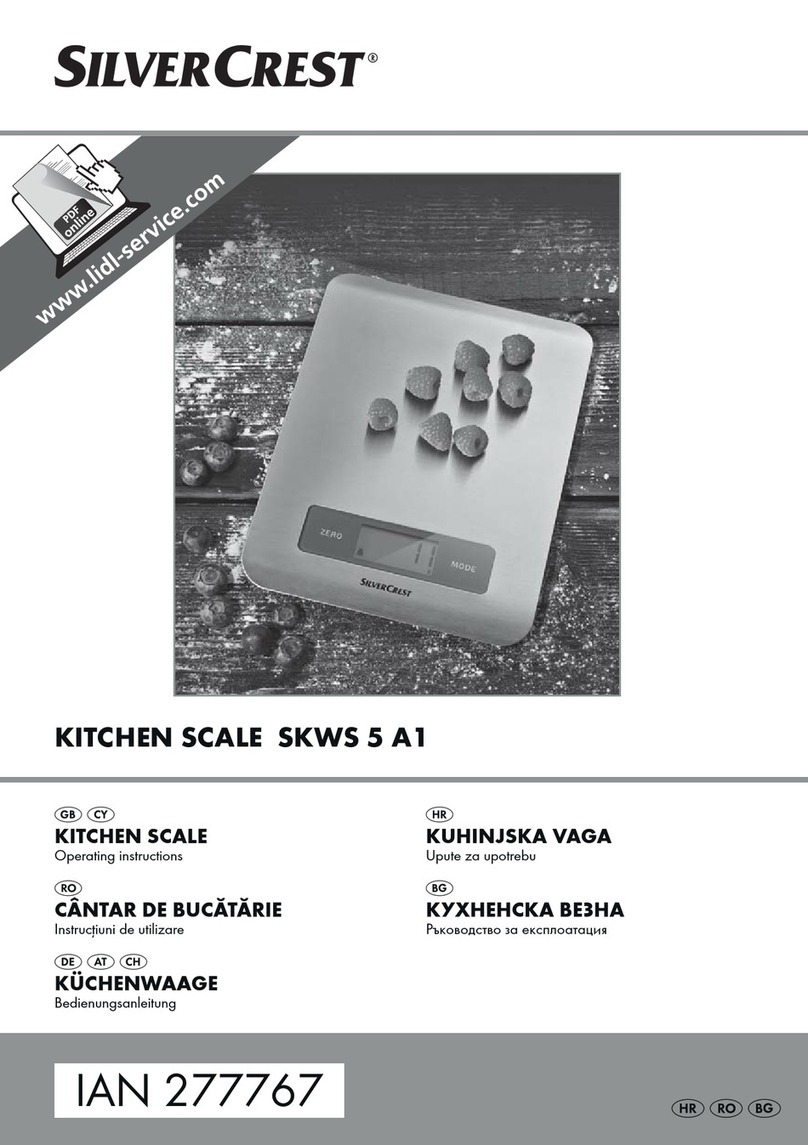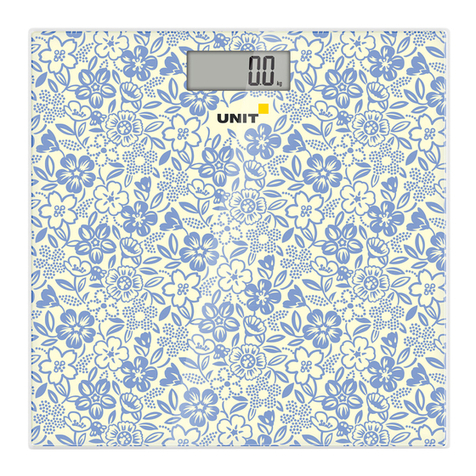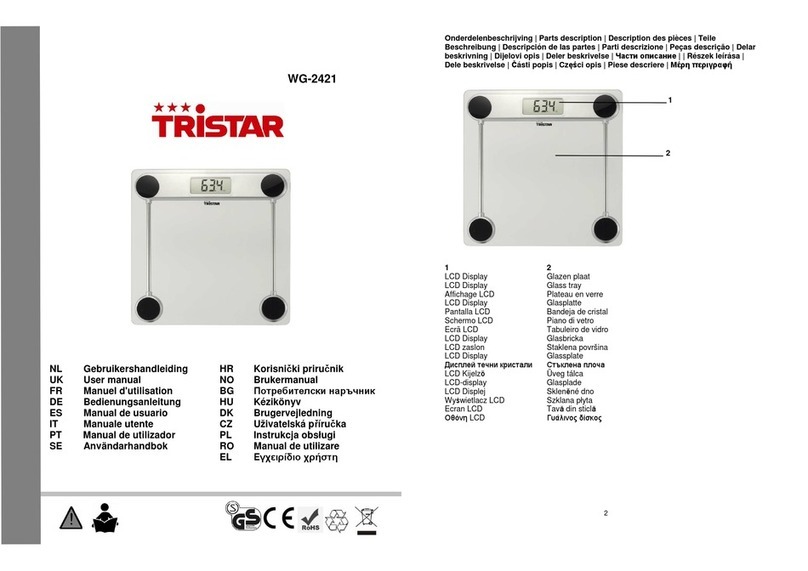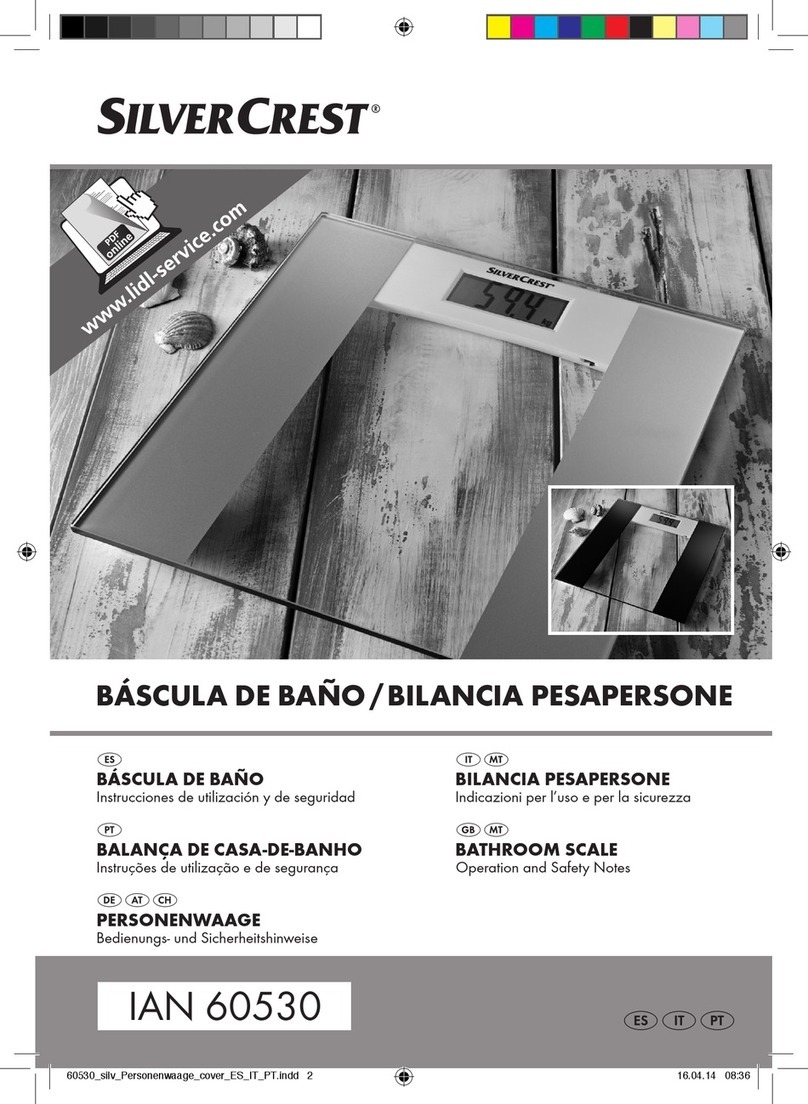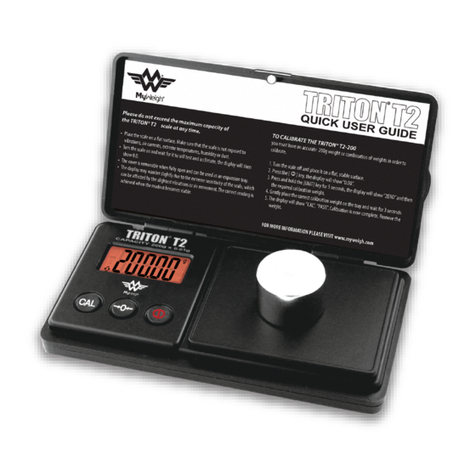General Measure Checkweigher User manual

Checkweigher
CW-100G
Us er’s manu al
( A p p l i c a b l e f o r M C G S + C 0 1 v e r s i o n )
531701010023Ver A1

Contents
1. Summary............................................................................................. 1
1.1 Product Features ........................................................................... 1
1.1.1 Mechanical part .................................................................. 2
1.1.2 Electrical part .....................................................................2
1.2 Usage Notice................................................................................2
1.2.1 Precautions ........................................................................ 2
2. Product installation ................................................................... 3
2.1 Overall appearance ........................................................................3
2.2 Mechanical installation...................................................................4
2.3 Electrical installation .....................................................................5
2.4 Electrical interface......................................................................... 7
2.5 Power supply power..................................................................... 11
3. Operation .................................................................................... 12
3.1 Operation summary................................................................. 12
3.2 Limit removal ......................................................................... 12
3.3 Basic operation ....................................................................... 13
3.3.1 Power-on operation .......................................................... 13
3.3.2 Zero clear operation.......................................................... 14
3.3.3 Start up operation ............................................................ 14
3.3.4 Stop operation.................................................................. 15

3.3.5 Power off operation .......................................................... 15
3.4 User login ............................................................................... 15
3.5 Product selection with New .................................................... 16
3.5.1 Select product parameters ................................................ 16
3.5.2 New product parameters................................................... 16
3.5.3 Modify product parameters................................................ 20
3.5.4 Delete product parameters................................................ 20
3.6 Calibration scale..................................................................... 20
3.6.1 The weight calibration scale .............................................. 21
3.6.2 Dynamic calibration of scale .............................................. 22
4. Data viewing ............................................................................ 25
4.1 Check the result data.................................................................... 25
4.2 Statistics.................................................................................... 26
4.3 Alarm information....................................................................... 26
4.4 Statistical graph .......................................................................... 27
5. Quantity of switches ............................................................... 28
5.1 I/O I/O testing ............................................................................ 28
6. Working parameters ................................................................ 33
6.1 Working parameter Settings .......................................................... 33
7. Communication .............................................................................. 38
7.1 Communication parameters........................................................... 38

7.1.1 Serial port communication................................................. 40
7.1.2 Network port communication............................................. 40
7.1.3 MAC address .................................................................... 41
7.2 The Modbus register communication address is defined...................... 41
7.3 Print content ............................................................................. 47
7.4 Set the parameters of the servo driver........................................ 48
8. Program upgrade ..................................................................... 50
9. Size .................................................................................................. 51
9.1 Outline size drawing (unit: mm)..................................................... 51
10. Equipment repair and maintenance ...................................... 53
10.1 Maintenance of motors ........................................................... 53
10.1.1 Routine maintenance ........................................................ 53
10.1.2 Regular maintenance ........................................................ 53
10.1.3 Precautions ...................................................................... 53
10.2 Check the failure cause and treatment method of weight scale . 53
10.2.1 No display on the touch screen.......................................... 53
10.2.2 Data pulsation large, abnormal fluctuation ......................... 53
10.2.3 The display is always zero ................................................. 54
10.2.4 Abnormal data display....................................................... 54
10.2.5 Busy alarm ....................................................................... 54
10.2.6 Packaging error ................................................................ 54

10.2.7 Continuous nonconformity alarm ....................................... 55
10.2.8 Excess plugging time ........................................................ 55
10.2.9 Below the minimum sampling time .................................... 55
10.2.10 Super maximum sampling time ........................................ 55
10.2.11 Overload motor load limit................................................. 55
10.2.12 Automatic zeroing failed .................................................. 55

Shenzhen General Measure Technology Co., Ltd. All rights reserved.
Without the permission of Shenzhen General Measure Technology
Co., Ltd., no unit or individual may copy, disseminate, transcribe or
translate into other language versions in any form or by any means.
Due to the continuous improvement and update of our products, we
reserve the right to modify this manual at any time without prior notice.
For this purpose, please visit our website frequently for timely information.
The company's Web address http://www.gmweighing.com

CW-100G (C01+MCGS)
1
1. Summary
CW-100G checkweigher is an industrial automatic checkweigher with high speed, high
precision developed by our company to meet the changing technological update.
Full touch screen (15 inch super large screen) makes CW-100G checkweigher easy to
operate, external expansion of IO input and output and external serial port communication
to achieve multi-point control, monitoring and remote control of the product.
1.1 Product Features
Product parameters;
Note; Scale stands are strictly prohibited from being used over the range.
Model number
CW-100G
Power supply
AC220V±10%, 50/60Hz, 350W
Weighing range
5 to 100g
Accuracy of weight
check
Plus or minus 0.1 ~ 0.5 g
Weight checking speed
100~300 pieces/min
Conveyor belt speed
10 to 70 m/min
Belt size
200mm*150mm
Center distance of drum
shaft
200mm
Table height
750 (±50mm)
Operating temperature
0 to 45ºC
Maximum humidity
90% R.H non-dew forming
Ultimate load
The instantaneous ultimate load shall not exceed
200g

CW-100G (C01+MCGS)
2
1.1.1 Mechanical part
1.The servo driver is used as the motor driving device to ensure the stability and
adjustability of the speed in the process of weight checking.
2. Double photoelectric mode more accurately determine the object up and down the
weighing platform, improve the accuracy and efficiency of weight detection.
3. Scale height adjustment range is larger, convenient for customers to choose to use.
4. Mechanical modular design makes transportation and maintenance more convenient
and application adaptability stronger.
1.1.2 Electrical part
1. Simple wiring, external only need to access the power cord; The internal use of
different specifications pin plug terminal block, wiring is convenient and will not make
mistakes.
2. Touch screen operation interface optimization, product parameter setting is simple
and the main interface content is richer.
3. The three-color indicator shows qualified (green), out-of-tolerance (red), under
tolerance (yellow), and the working state of the inspection weight is clear at a glance.
Buzzer user can define the alarm mode.
4. The new algorithm is adopted in the process of weight inspection, and the high
precision can be guaranteed in the process of high-speed weighing.
5. Optimize user login and logout function, without tedious operation and effectively
prevent others from disoperation.
1.2 Usage Notice
1.2.1 Precautions
1. Do not perform mechanical or electrical maintenance while live, do not place tools on
the scale, and do not perform welding operations on the scale.
2. The installation site must ensure the ground level, after installation through the
foundation adjustment, ensure that the weighing table level, tilt does not exceed 0.5
degrees, away from the vibration source.
3. Make sure the equipment is safely grounded and there is no strong electricity or
magnetic field interference nearby.
4. Do a good job of fire prevention, avoid direct sunlight to check the weighing table and
relatively strong air flow (outdoor air, fan and air conditioning outlet is directly against
the weighing table).
5.Should avoid squeezing, stepping on the scale platform, handling should first fixed
scale, installed sensor limit to prevent damage to the sensor, prohibit the direct handling
of the scale platform to move.

CW-100G (C01+MCGS)
3
2. Product installation
2.1 Overall appearance
The product appearance is shown in Figure 2 -1 below.
Figure 2-1 Overall appearance of the product
Serial
number
Name
Introduction
1
Indicator light
A more intuitive display of the test results, so
that the distance can also see the results of the
state.
2
Touch screen
View display data and set product parameters

CW-100G (C01+MCGS)
4
3
Emergency
stop button
Emergency stop
4
Electric
control box
Control the weight checking process and connect
external devices
5
Knob switch
On/off check scale power
6
Photoelectric
sensor
Judging object up and down weighing table
7
Photoelectric
reflectors
Use in conjunction with photoelectric sensors
8
Check the
weight scale
table
The object to be measured is called the heavy
load platform
9
Conveyor belt
The delivery end of the scale table on the object
10
Culling end
belt
Disqualified products are culled at this location
11
Eliminate the
air blowout
Cull substandard products
12
Footing
Prevent the scale from sliding and shaking, and
adjust the level of the weighing table.
13
Storage box
Store rejected nonconforming products
2.2 Mechanical installation
Place the checkweigher at the installation place and remove the sensor protection
device; Adjust the levelness of the checkweigher, and the inclination shall not exceed 0.5
degree; Fix the footing of the checkweigher, the stainless steel footing contacts the ground
smoothly, and lock the screws of the footing to ensure the stability of the checkweigher.
Adjust the distance between the check weighing platform and the front and rear end
conveying mechanism is 9 ~ 11mm, and the check weighing platform shall not be in
contact with other equipment. If the front and back end conveying mechanism is not equal
to the height, it is necessary to add the oblique conveying mechanism on one side, and add
the horizontal conveying mechanism connection on the side of the oblique mechanism (to
leave a gap) to check the weight scale platform, to ensure that the check weight scale
platform level and the height of the front and back end conveying mechanism.

CW-100G (C01+MCGS)
5
The electric control box can be arbitrarily installed on the left and right sides of the
checkweigher to facilitate the operation of the production process.
2.3 Electrical installation
The power supply is inserted into the three-hole socket with ground or connected to
the power supply equipment such as the electric gas cabinet according to the line mark.
Any wiring and disconnecting operation can only be carried out after power off. After
the operation is completed, check before power on.
2. The serial port is fixed to RS485 communication, where the 485(A) pair should be
connected to 485(A) or 485(+), and the 485(B) pair should be connected to 485(B) or
485(-).
3. The switching quantity input point is valid at low level (DC0V) and does not allow
access to high voltage or alternating current.
4. Switching quantity output point access relay coil for intermediate control, so the
other end of the relay can access DC or AC power supply switching quantity.

CW-100G (C01+MCGS)
6
Figure 2-2 Control panel of checkweigher
Serial
number
Function
1
Touch screen communication jack
2
External custom outlet OUT1-OUT4
3
External custom output relay K1-K8
4
Detect the photoelectric sensor wiring terminals
5
Alarm light wiring terminals
6
Custom input ports 1-6 externally

CW-100G (C01+MCGS)
7
7
Sensor terminal
8
External RS-485 communication jack
9
External TCP/IP communication network port
10
Inverter communication jack
11
External USB data interface
12
24V power terminal
13
Reset key
14
Communication status indicator
15
Output relay status indicator light
2.4 Electrical interface
Photoelectric sensor (already wired at factory):
E24V: photoelectric sensor DC24V+.
E0V: photoelectric sensor DC24V-.
E1: Signal input of photoelectric sensor for loading of checkweigher.
E2: Check the output photoelectric sensor signal input of the weight balance.
Alarm light (has been connected when leaving the factory):
L24V: Alarm light DC24V+, maximum output power 2VA.
L1: Buzzer.
L2: When the detection result is out of tolerance, the low output is valid until the next
check begins.
L3: When the test result is qualified, the low output is valid until the next check begins.
L4: When the detection result is inferior, the low level output is effective until the next
check starts.
Input (function can be customized, onsite connection according to actual
demand):
DI1: running input. In the stopped state, the input is valid and the system enters the
running state.
DI2: Stop input. In the running state, the input is valid and the system enters the stop
state.

CW-100G (C01+MCGS)
8
DI3: clear the alarm. When the system generates an alarm, change the input to be
effective and the alarm will be cleared.
DI4: out-of-tolerance elimination is completed. When the input is valid, the output of
out-of-tolerance elimination is invalid.
DI5: Under error culling is complete, under error culling output is invalid when this input
is valid.
DI6: continuous packet detection. This input signal is given by the photoelectric sensor
installed on the front conveyor line of the checkweigher and used in conjunction with the
busy stop output to control the start and stop of the front conveyor line of the checkweigher.
When there is an object being detected on the weighing platform and the signal is effective,
the busy stop output is effective.
DI0V: switching quantity power supply DC24V-.
DI24V: Switching quantity power supply DC24V+.
4 transistor outlet (function can be customized, on-site according to the
actual demand connection):
DO1: No definition.
DO2: undefined.
DO3: undefined.
DO4: undefined.
DO0V: switching quantity supply power DC24V-.
DO24V: switch quantity power supply DC24V+.
DOCOM: switch quantity common end.
Sensor (already connected at factory):
EX+: Power positive, SN+: induction positive, EX- : power negative, SN- : induction
negative, SG+: signal positive, SG- : signal negative.
Motor speed control communication interface (RS485):
MT A: RS485 communication A.
MT B: RS485 Communications B.
MT G: RS485 Communication (GND).
8-way relay outlet (function can be customized, on-site connection according
to actual demand):

CW-100G (C01+MCGS)
9
K1: defined as operation. When the system is in operation state, the relay output is
closed, and K1A and K1B are switched on. Used to control the start and stop of frequency
converter.
K2: defined as stop. When the system is in the stopped state, the relay output closes
and K2A and K2B are switched on. This definition is the factory default setting and can be
modified according to the actual needs.
K3: defined as out of tolerance elimination, the product test result is out of tolerance,
and within the range of out of tolerance elimination duration, the relay output is closed, K3A,
K3B switched on. This definition is the factory default setting, and can be modified
according to the actual demand.
K4: defined as under error elimination, product detection result is under error, and
within the range of under error elimination duration, the relay output is closed, K4A, K4B on.
This definition is the default setting of the factory, and can be modified according to the
actual demand.
K5: defined as alarm. When alarm occurs in the system, the output of the relay is
closed and K5A and K5B are switched on. This definition is the factory default setting, and
can be modified according to the actual demand.
K6: defined as batch completion, after the completion of the product test batch, the
relay output is closed, K6A, K6B on. This definition is the factory default setting, and can be
modified according to the actual demand.
K7: defined as qualified indication, after the product test is qualified, the relay output is
closed, K7A, K7B on. This definition is the factory default setting, and can be modified
according to the actual demand.
K8: defined as rejection of unqualified. When unqualified is detected, the output of the
relay is closed, and K8A and K8B are switched on. This definition is the factory default
setting, and can be modified according to the actual demand.

CW-100G (C01+MCGS)
10
Figure 2-3 Schematic diagram of inlet and outlet connections
Figure 2-4 Power supply and motor interface diagram
Figure 2-4 shows the power supply and motor interface diagram, defined as follows:
External power supply (already connected at factory):
L: external AC power live wire.
G: external AC power ground cable.
N: neutral wire of external AC power supply.
Frequency converter output power supply (factory has been connected):
U: Corresponding to the U terminal connected to the motor.
V: corresponds to connect the motor V terminal.
User provide
OUT1~4 can
self-defined
User provide
User provide
IN1~6 can
self-defined
K1~8, K2~7 can
self-defined
If need connect
external relays,
please connect
in this way
Rejector mechanism
solenoid valve

CW-100G (C01+MCGS)
11
W: corresponds to connect the motor W terminal.
Note: L, N and G are the external AC power supply, and U, V and W are the output
power supply of the inverter to power the motor. These two groups of power supplies have
been connected before delivery. If the frequency converter or motor needs to be
reconnected in the subsequent use and maintenance process, please be sure to connect
correctly according to the instructions, and remember not to connect it backwards,
otherwise it will cause damage to the frequency converter.
2.5 Power supply power
AC220V±10%, 50/60Hz, 350W.

CW-100G (C01+MCGS)
12
3. Operation
3.1 Operation summary
Figure 3-1 Procedure
3.2 Limit removal
Before use, the two limit bushings need to be installed from the transport position to
the working position. The position indicated by the arrow in Figure 3-2 is the installation
position of the limit bushings.
Figure 3-2 limit position
Technician
login
w
h
e
n
b
e
f
o
r
e
P
r
o
d
u
ct
New product
Set
parameters
Starting
weight
check
Data
query
Power
off
c
h
o
o
s
e
C
h
o
o
s
e
t
h
e
p
r
o
d
u
c
ti
o
n
p
r
Boot
Limit bushing install at here during
transportation
Limit bushing install at here when
working

CW-100G (C01+MCGS)
13
3.3 Basic operation
The main interface of weight inspection is used for daily production, which is used to
start and stop the weight inspection belt, enter the relevant parameter interface and
display the basic information of the tested product and the weight inspection result.
3.3.1 Power-on operation
Power on and turn the knob switch to the "1" position. The power-on touch screen of
the electric cabinet displays the initialization interface. At the top of the interface are USB
insert mark, check scale model and time display; The black display area is the name of the
current production inspection product, the weight display area, the weight unit display area
and the weight check scale status display area; In the middle is the current setting of
weight checking speed, the current actual weight checking speed and the display statistics
of weight checking results; At the bottom are the function keys of the operation of the
weight check scale and the parameters related to the weight check.
Correct time parameters can effectively help users check the production inspection results,
relevant production parameter changes and alarm information, help to improve the
production pass rate and production speed and reduce production consumption.
The weight display area of the checkweigher displays the real-time weight value in the
stopped state, and displays the weight test result in the running state until the next
object is effective.
Figure 3-4 Power-on initialization interface
Button and operation frame operation instructions (applicable to all operation interfaces of
the device) :

CW-100G (C01+MCGS)
14
1. Click this button to enter the interface of creating products and setting product
parameters.
2. Click this button to enter the parameter setting interface.
3. Click this button to enter the data interface to view the relevant check data.
4. Click this button to clear zero.
5. Click this button for user management operations.
6. Click this button to start and stop the device.
7. Click this type of action box to modify the value of this item.
8. Click the action box to modify the value of this item.
9. Click this type of action box to select Settings for this definition.
10. Click this type of action box to perform the corresponding operation.
11. Click this type of action box to open and close the corresponding function Settings.
3.3.2 Zero clear operation
If the touch screen displays the real-time weight value of the checkweigher in the
stopped state is not zero (zero indicates the off state), click "Clear zero" to clear the
weighing platform, so that the real-time weight value is displayed as zero, and then the
zero indicates the on state.(It can be operated only in the stopped state).
If the weight check scale shows that the weight is unchanged, the stable identifier bit
is on; otherwise, the stable identifier bit is off (the stable identifier bit is only related to the
weight state, and has nothing to do with the operation of the checkweigher and the size of
the weight value).
3.3.3 Start up operation
Click "Start" on the touch screen to start the weight checking scale, and the weight
checking motor drives the weight checking belt to rotate. At this time, the operation label
on the touch screen is "Running", and the weight checking operation can start.
Other manuals for Checkweigher
1
This manual suits for next models
1
Table of contents
Other General Measure Scale manuals
